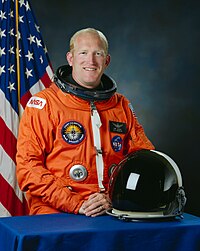Charles D. Gemar
| Charles Donald Gemar | |
 | |
| NASA-astronaut | |
|---|---|
| Född | 4 augusti 1955 Yankton, South Dakota |
| Tid i rymden | 24 dagar, 5 timmar, 38 minuter |
| Urvalsgrupp | Astronautgrupp 11 |
| Uppdrag | STS-38, STS-48, STS-62 |
| Uppdragsemblem | |
Charles Donald "Sam" Gemar, född 4 augusti 1955 i Yankton, South Dakota, är en amerikansk astronaut uttagen i astronautgrupp 11 den 4 juni 1985. Han har tidigare varit officer och pilot i USA:s armé.
Rymdfärder
Media som används på denna webbplats
STS-62 Mission Insignia
STS-38 Mission Insignia
NASA Astronaut Charles D. (nickname Sam) Gemar
STS-48 Mission Insignia
- Designed by the astronaut crewmembers, the STS 48 patch represents the Space Shuttle Orbiter Discovery in orbit about the Earth after deploying the Upper Atmospheric Research Satellite (UARS) depicted in block letter style. The stars are those in the Northern Hemisphere as seen in the fall and winter when UARS will begin its study of Earth's atmosphere. The color bands on Earth's horizon, extending up to the UARS spacecraft, depict the study of Earth's atmosphere. The triangular shape represents the relationship among the three atmospheric processes that determine upper atmospheric structure and behavior: chemistry, dynamics and energy. In the words of the crewmembers, This continuous process brings life to our planet and makes our planet unique in the solar system."





